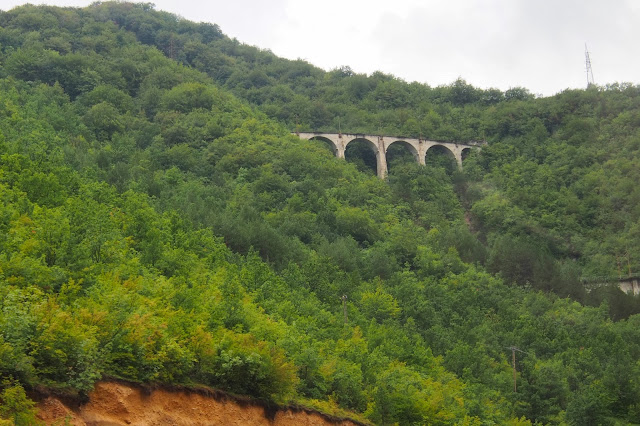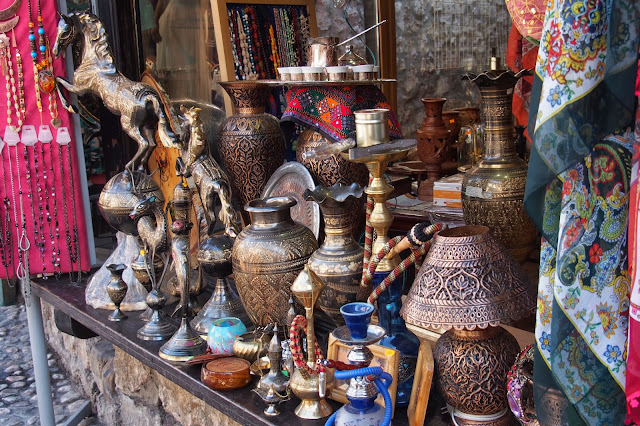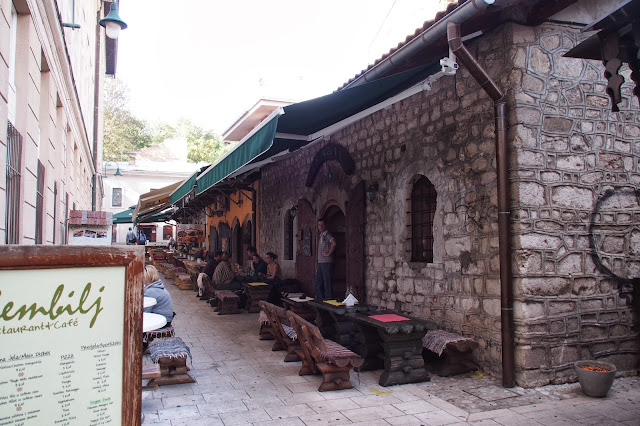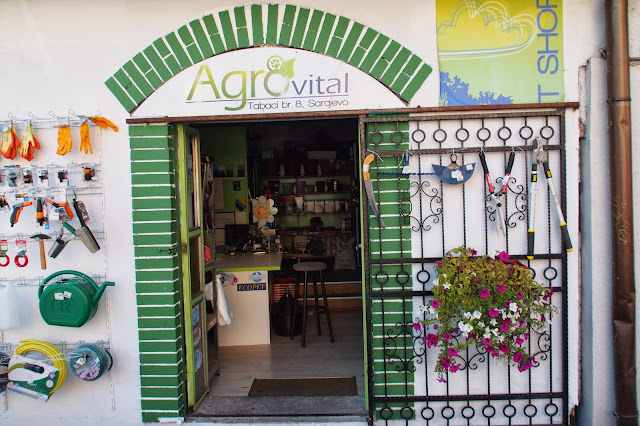After Belgrade, we had to go to another city, Sarajevo in Bosnia, the following morning

The sky looked promising. But first we had to have dinner
The decorations at our hotel restaurant
First some appetizers: ham and chesse
Some iced orange juice
A pork chop: nothing to rave about
Then into the hotel room for a good rest
View from the hotel room: the weather doesn't look good, storm clouds gathering
Before the long journey, some breakfast
it had been raining the previous night
Water on the leaves everywhere but still some sunlight: a little hope!
Raindrops whilst waiting for the late arrivals
We're on our way soon: a house we saw from the coach window
A small hillside town we passed
A railway bridge
Another village by the river
The water of the river looks calm
Mist rising in the river
We stopped by for some rest before the journey continued: a nice roadside restaurant with a water mill, which helps to turn the chicken/pig roasting machine above the stove in an open charcoal fire
The inside of the restaurant
Nice and comfortable outside
Our first view of Sarajevo, an impressive building with Arabic arches and patterns. It's the capital and largest city of Bosnia and Herzegovina, its political, economic and cultural centre and is home to slightly more than 300,000 of Muslims, Orthodox, Catholic and Jews and including its suburbs 450,000. Situated 1700 feet above sea level, in the greater Sarajevo valley of Bosnia fed by Miljacka River, it's surrounded by the Dinaric Alps. Because of its mix of religion, it's been dubbed the "Jerusalem of the Balkans" and until recently, the only major European city with a mosque, a Catholic Church, an Orthodox church and a synagogue within a short distance of each other. And although the area was settled even in prehistoric times, it only started to really flourish in the 15th century when taken over by the Ottoman Turks in 1429. In 1461, the governor there started to build a mosque, a closed marketplace, a public bath, a hostel, and the governor's castle ("Saray").
Of course, everyone knows now the Latin Bridge there, where the Archduke of Austria Franz Ferdinand of Austria was assassinated, along with his wife
Sophie, Duchess of Hohenberg in Sarajevo on 28 June 1914 by a
self-declared Yugoslav, Gavrilo Princip, the event which triggered the alliance systems into WWI in 1914.It's also the site which hosted the winter Olypmics of 1984 because it got 4 of the highest mountains in the region: Treskavica at 2,088 meters
(6,850 ft), Bjelašnica at 2,067 meters (6,781 ft),
Jahorina at 1,913 meters (6,276 ft), Trebević at 1,627 meters (5,338
ft), with 1,502 meters (4,928 ft) Igman being the lowest. The last
four are also known as the Olympic Mountains of Sarajevo.
The original settlers were Daesitiates, a branch of the Illyrians, a war-like people who resisted Roman conquest until 9 AD. After the Romans, the place was successively occupied by the Goths and then in the 7th century by the Slavs. it was during the reign of the 2nd Turkish governor Gazi Husrev-beg that the present Old Town took shape and by the 16th century, more than 100 mosques had been built and it became the second most important Turkish town in the Ottoman Empire and in the late 17th century, it already had a population of more than 80,000 (cf. Belgrade 13,000 and Zagreb 14,000).
After World War I and contributions from the Serbian army alongside
rebelling Slavic nations in Austria-Hungary, Sarajevo became part of the
Kingdom of Yugoslavia. During World War II, Sarajevo was captured on
15 April 1941 by the Germans and the Axis powers
created the Independent State of Croatia and included Sarajevo in it. But the city was heavily bombed by the Allies in 1943 and 1944. The Bosnian resistance was led by a NLA Partisan named "Walter" Perić, who died while
leading the final liberation of the city on 6 April 1945. Following
the liberation, Sarajevo became the capital of the Socialist Republic of
Bosnia and Herzegovina, forming part of the Socialist Federal Republic of
Yugoslavia which invested heavily in Sarajevo,
building many new residential blocks and simultaneously developing the city's
industry and transforming Sarajevo from the post-war population of 115 into a modern city.
When Bosnia and Herzegovina declared
independence from Yugoslavia in 1992, it had to fight for 4 years! From 1992-1996, it was the site of the fiercest fighting during its war
of independence. Although it achieved United Nations recognition,
the Serbian leaders and army whose goal was to create a "greater
Serbia", declared a new Serbian national state Republika Srpska (RS)
which was carved from the territory of Bosnia and Herzegovina, so they
encircled the Bosnian Sarajevo with 18,000 men in the
surrounding hills, from which they shelled the city with artillery, mortars, tanks, anti-aircraft guns, heavy
machine-guns, multiple rocket launchers, rocket-launched aircraft bombs,
and sniper rifles. From 2 May 1992, the Serbs blockaded the city.
Since the Bosnian government defence forces in the besieged city were
poorly equipped, they could not break the encirclement. During this war of independence, it lost 11,541 lives, including over 1,500
children with an additional 56,000 wounded, including nearly
15,000 children.The 1991 census indicates that before the siege the
city and its surrounding areas had a population of 525,980. But post-war rebuilding is fast and it has been
nominated as the European Capital of Culture in 2014 and will host the
2017 European Youth Olympic Festival. it's name is the Slavicized
Turkish word "Saray", meaning governor's palace or office and "evo"
meaning "plains around the palace" . If a place is fortified, it
would be called a "kale" in Turkish, meaning "castle". It's not so here.
From its complicated history, we can expect that city would have a unique blend of the East and the West. It still retains the Ottoman city market of old but also has contemporary western architecture. Sarajevo boasts some examples of Secession- and Pseudo-Moorish styles that date from this period. Many of the WWII shell casings that were used during the attacks have now been carved and polished in Sarajevo tradition and are sold as art to tourists.
Its average yearly temperature is 10 °C (50 °F), with January (−0.5 °C
(31.1 °F) avg.) being the coldest month of the year and July (19.7 °C
(67.5 °F) avg.) the warmest. As it has
oceanic, humid continental and humid subtropical zones, it has four seasons and rain all year round spread over 75 days and is cloud-covered nearly half of the time every year.
This is where we stopped for lunch. It's a restaurant called Inat Kuca and has an interesting history. Originally, when the Austrian-Hungarian Empire took over the city, it wanted to build a town hall and chose as its site the home of a local who refused to budge unless the government promised to give him sufficient gold to enable him to build another house of his choice at a location across the river from where he originally was. The wrangle lasted years but finally the Government had to give in. This restaurant used to be his "house in exchange"!
This restaurant serves Turkish and Arabian food.
It's filled with artifacts from the East
Old coffee grinder for thick black Turkish coffee
Incense burners
Wine jug and old scale
All kinds of daggers, swords, guns and rifles etc.
All kinds of wine, juices and oils
We had stuffed green pepper risotto with mutton as stuffing : delicious.
and for dessert a kind of pudding with chestnut paste: yummy
Outside the restaurant we can see the Miljacka River which originated from the town of Kale in the east
And behind the restaurant a road which leads uphill
You find mosques everywhere in this city: this one is right behind our restaurant
This is the Latin Bridge, where that fateful assassination took place
This used to be the Governor's Palace
A pavilion in a public park nearby

The entrance to the Arabian quarters
This is the remains of the Taslihan (meaning "inn made of stone) , the original caravansarai or inns built by the first Turkish governors in 1453 by artisans from Dubrovnik, with 2 floors, the ground floor for stores and stables for 70 horses and the upper floors could house 30 to 90 guests, each room with its own chimney. Next to it is the covered market Bezistan (meaning "covered market building") , now turned into a tourist bazaar
A bronze horse on sale at one of the shops in the bazaar
A stone fish on sale
Scarves galore
a lady carefully doing embroidery
Trinkets for ladies
Souvenirs for tourists
woolen sock, shoes, hats etc
boxes, caskets, shields, piped wind instrument, knives...
Ceramics, boxes, wooden containers, ashtrays etc
postcard size pictures
A whole street of shops for the delight of ladies
Some paintings for sale to tourists, obviously of so so quality
Scarves. Is the painting like them or vice versa?
And not far away, a very contemporary building. Upon inquiry, I learned that it's a library, a gift from Saudi Arabia
A young couple meeting at its gate
Another look at the library
its patio
I walked uphill and found this little mosque
right next to a cemetery: people everywhere wants to honour their dead
As everywhere in the Balkans, people like to have flowers on their balcony
strolling down a quiet little path back to the Arabian quarters
An old and discolored door
Another old door
People here seem to like bold outlines and simple colors
Another door, very thoughtful: nice blend of color
A street leading to the Arab quarters
The Arabian quarters is full of bars and restaurants
a shop selling Arab handicraft
one of the bar restaurants
Another one
A third, each one has got its own unique style
This one is hidden inside a court yard
This one is in a court yard under trees next to a public well
Many buildings had an interior courtyard
This one looks really cosy. But I was short of time
Two ladies of leisure enjoying their quiet afternoon tea and tête-à-tête
back into the main street
An electric tram. It's the first city in Europe to have electric trams after San Francisco, which is the first in the world.
Signs of the passage of time or of war?
Old fashioned window in green
A gardener's shop
a last look at the governor's house: how small under the white clouds!
A last look at the Miljacka River which will eventually join with the Bosnia River in the west
















































































沒有留言:
張貼留言